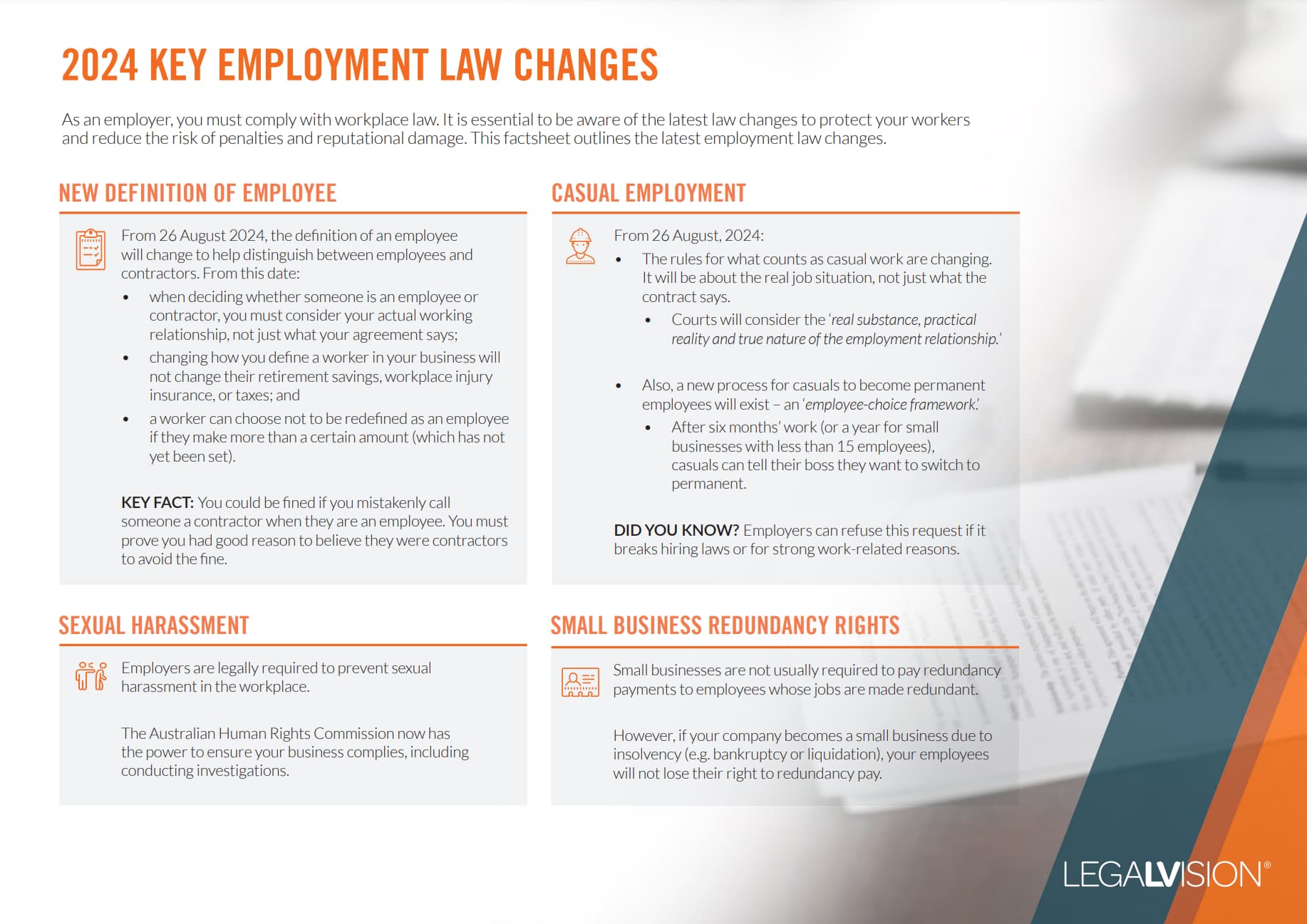In Short
- Employers have a legal obligation to prevent and address workplace bullying under WHS and anti-discrimination laws.
- Bullying involves repeated unreasonable behaviour that poses a health and safety risk to employees.
- Investigate bullying incidents, talk to all parties involved, and seek legal advice if necessary.
Tips for Businesses
To prevent and manage workplace bullying, ensure you have a clear Workplace Health and Safety Policy. Create a supportive workplace culture, talk to all parties involved when bullying arises, and address any structural issues that might contribute to bullying. Always keep detailed records and seek legal advice when required.
Every person has a right to a workplace that is free from bullying. For this reason, if a staff member is being bullied, it is your responsibility as an employer to respond to the instance of bullying immediately. To help you respond to workplace bullying, this article outlines some key points for employers to remember when taking steps to put a stop to workplace bullying.
Take Responsibility
If you think one of your employees is being bullied, alarm bells should be ringing. As an employer, you have a responsibility to protect your employees from bullying under workplace health and safety (WHS) laws and anti-discrimination laws. One step you can take to achieve this is to have a Workplace Health and Safety Policy in place.
In addition, under WHS laws, bullying is deemed to be a psychosocial hazard. Psychosocial hazards are workplace hazards that result in stress which in turn can result in either physical or psychological harm to employees, such as:
- anxiety;
- depression;
- PTSD; and
- fatigue-related injuries.
As psychosocial risks are considered hazards under WHS laws, persons conducting a business or undertaking (PCBUs) must eliminate these hazards in their workplace or, if that is not reasonably practicable, minimise them as far as is reasonably practicable.
As a result of this, you have a WHS obligation to investigate and take all reasonable steps to eliminate or minimise bullying in the workplace. This can be either an informal or formal investigation.
Identifying Bullying In the Workplace
It is important to understand the legal definition of bullying. Under the Fair Work Act, an employee is bullied in the workplace if an individual or group:
- repeatedly behaves unreasonably towards them; and
- this behaviour creates a risk to their health and safety.
So if a person is clearly becoming upset by another person’s behaviour at work, then this should put you on alert. However, it is important to consider whether the behaviour in question may be seen to be a reasonable management action carried out in a reasonable manner. In determining whether something is a reasonable management action, you should consider the nature of the role and relationship between relevant employees. For example, it might be reasonable to tell someone to correct their mistakes, but it is not reasonable to yell at them in front of everyone about it. If you have carried out reasonable management action in a reasonable manner, this will not be considered bullying.
Workplace bullying can take a number of forms and they are not always as obvious as you might think. Remember that ‘mind games’ rather than overt harassment are frequently cited as the most common type of workplace bullying. Additionally, bullying can be direct or indirect behaviour that humiliates an employee, such as:
- direct threats of harm, offensive language, or acts of violence; and
- indirect behaviour, such as deliberately excluding an employee from workplace activities or spreading malicious rumours about another employee.
Understand Why the Bullying is Happening
Ask yourself, is there something about your workplace that is creating bullying? For example, the:
- workplace could be overly-competitive;
- workplace could be too fragmented;
- employees could be under too much stress; or
- staff may need to undergo retraining.
You should consider whether the culture in your workplace is healthy and productive.
If this is the case, you will likely need to address not only the bullying incident but also the structural features of your business that prevent a bully-free environment.
Also, you should make sure that your actions do not further isolate the victim. Instead, you should investigate:
- why bullying is happening;
- underlying structural causes for the issue; and
- ways in which you could address these causes to prevent further bullying.
Talk to All Parties Involved
You must speak to all parties involved so that you understand all sides of the story. You need to make it clear that there is a zero-tolerance approach to bullying in your workplace and that workplace bullying can take many forms. By talking to all parties involved, you can attempt to resolve the issue informally.
If both parties are able to informally have a conversation outlining their grievances and resolve the matter, then this should be encouraged. However, this should only be done if both parties are comfortable with this scenario. You are also required to consider the physical and mental health of your employees.

As an employer, it is essential to understand what employment laws have changed and their implications for your business — particularly the changes to the Fair Work Act 2009 through the new Closing the Loopholes legislation.
Start a Formal Investigation
If you believe that disciplinary action is warranted, you should initiate a formal investigation into the matter. This is because if disciplinary action results in termination or suspension of employment, you will have a record that indicates that you properly investigated the complaint. As mentioned above, if you neglect an instance of bullying, you could face serious consequences from the FWC, especially if your employee files a stop bullying application.
The aim of a formal investigation is to analyse the circumstances in which the bullying took place. As part of your formal investigation into workplace bullying, you should appoint an experienced internal or external person to report on the matter. This can be an experienced human resource manager or an employment lawyer.
The investigation process will generally involve interviewing the complainant, the person against whom the complaint was made and any other relevant witnesses. The alleged perpetrator should be permitted to provide their responses to the relevant allegations.
Ideally, the investigator will then record the outcome of the investigation in a report which will:
- list the relevant facts with respect to the bullying;
- balance those facts with applicable laws; and
- assess whether workplace bullying can be proven or if the evidence is inconclusive.
Finally, the report should include some recommendations on how you should respond to instances of workplace bullying. This can include:
- taking disciplinary action;
- conducting further training for staff via anti-bullying workshops; and
- implementing a zero-tolerance bullying policy.
Seek Legal Advice
Bullying is a complex matter and can result in serious legal, reputational and financial ramifications for a business. If the situation is becoming serious, you should seek legal advice. An experienced employment lawyer can advise you on:
- the further steps you should take to resolve this specific instance of bullying; and
- ways to prevent future bullying in the workplace in order to fulfil your responsibility to ensure a bully-free workplace.
Key Takeaways
An employee is bullied in the workplace if an individual or group repeatedly behaves unreasonably towards them, where this behaviour creates a risk to their health and safety. If a staff member is being bullied, you should:
- immediately respond to the matter;
- identify any other instances of bullying in the workplace;
- understand why bullying is occurring in your workplace;
- speak to all those involved in the matter;
- initiate a formal investigation (if warranted); and
- seek legal advice.
If you need help responding to an instance of workplace bullying, our experienced employment lawyers can assist as part of our LegalVision membership. For a low monthly fee, you will have unlimited access to lawyers to answer your questions and draft and review your documents. Call us today on 1300 544 755 or visit our membership page.
Frequently Asked Questions
Workplace bullying is defined under the Fair Work Act as repeated unreasonable behaviour by an individual or group towards an employee that creates a risk to their health and safety.
Workplace bullying can include direct actions such as threats, offensive language, or violence, as well as indirect actions like exclusion from workplace activities or spreading malicious rumours.
We appreciate your feedback – your submission has been successfully received.











